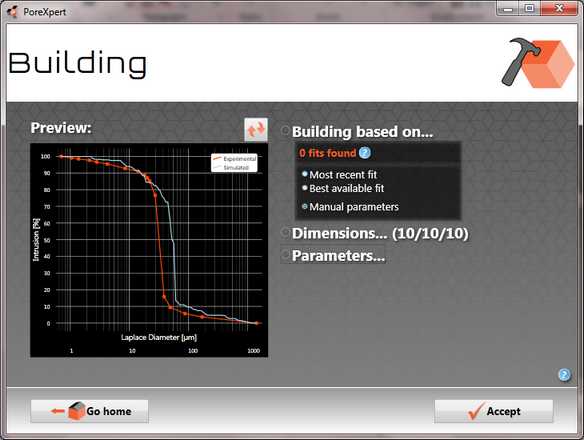Cell Engineering
Cell Engineering is an option available on the welcome screen of PoreXpert, and allows you to use PoreXpert without an experimental datafile. The biggest benefit of the Cell Engineering feature is the ability to edit one parameter that the simplex uses to fit experimental data or change the porosity of the sample and see how this affects the structure generated and any properties of the material.
In this tutorial the default cell engineering settings will be used which represent a simplex fit for a sandstone. The figure below shows the cell engineering screen, which is based on the building screen.

Cell engineering screen available from the welcome page or by using the command add a manual unit cell from the PoreXpert File menu.
The above figure shows the experimental data for Fontainebleau sandstone and in red and the simulated fit in the light blue in the preview screen. If you expand the parameters screen and change the pore skew or throat skew value the simulated fit will change when you press the refresh button.
The parameters selected by the user do not guarantee a simulated intrusion curve as the parameters selected may be invalid, which means a structure can not be created.
| • | Try changing the dimensions of the unit cell to investigate how the simulated fit changes. |
| • | Open the parameters menu when the dimensions have been reset to 10/10/10 |
| • | Try changing the parameters such as porosity, maximum and minimum feature size, structure type investigate how the simulated fit changes and then build the unit cell and compare the permeability for air with the default air permeability of 9.19 mDarcies. |
| o | Change the maximum feature size to 500 microns and investigate how the unit cell visualisation changes, this is a useful method to remove possible edge effects from the mercury porosimetry data. |
The cell engineering features explained above can also be used with experimental data by selecting add a manual unit cell to any operation list, it can also be used after any engineering operation when the unit cell has been resized, or reshaped.
